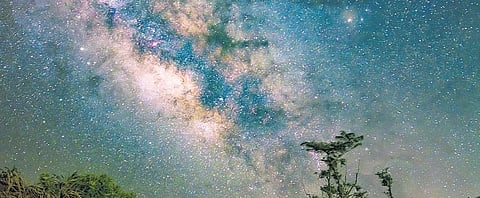

When thoughts begin to churn in our minds, when despondency grips us, or when the acme comes, people generally glance at the sky. Often at night, when the stars glitter and the moon bares many secrets in darkness, we drown ourselves in the mystery of the Milky Way. That band of light has more unanswered questions than our imaginations can fathom.
With eyes fixed on a telescope, there is astonishment at what goes on in the buzzing centre of the Milky Way. In June 2023, researchers came up with a different portrait of the Milky Way, charting the galaxy using something else than the light rays, reported Nature. Tracking neutrinos, the lightest, most pervasive of the universe’s elementary particles, an artist’s impression showed that it would look bluish.
Data from the IceCube observatory at the South Pole was compiled over a decade. An array of 5,160 sensors below 1.5km of the ice sheet’s surface detected neutrinos, one at a time, and tracked their directions. Researchers, who traced its origin to the centre of the Milky Way, called the first neutrino map of the galaxy a milestone in the field of neutrino astronomy.
Mapping the galaxy using high-energy neutrinos was a priority, but the path was filled with impediments. The majority of neutrinos recorded by the observatory are created in the atmosphere, roughly every five minutes, much higher than the rate in deep space, said IceCube spokesperson Francis Halzen, a physicist at the University of Wisconsin–Madison.
It compelled experts to collate years of data before a signal would appear. Second, a geographical hurdle. Neutrinos travel freely and reach the South Pole from beneath. Signals from points below the horizon are easier to separate from those that hit the detector from above, mostly coming from the massive cousins of electrons, muons. The team had to comb through 59,592 detections from May 2011-21. An estimated 7% of those neutrinos originated from deep space. Finding point sources in the Milky Way could begin to solve the origins of the cosmic rays.
Neutrinos have an advantage: the galaxy’s magnetic field cannot deflect its route as it travels in straight trajectories. That which eludes explanation is from where the cosmic rays in interstellar space come from. “We know that these neutrinos must be produced within the galaxy,” says Teresa Montaruli, an IceCube physicist at the University of Geneva, Switzerland. So far, attempts to locate point sources of cosmic rays have failed.
Researchers compared the neutrino information to data on high-energy gamma rays in the Milky Way to find both had the same origin, implying these neutrinos were a result of the cosmic rays originating in and around the Milky Way’s central disk. “This is like a quantum leap…” Kathrin Valerius, a physicist at the Karlsruhe Institute of Technology in Germany, told Scientific American.
Key to glow
Neutrino is a subatomic particle that has no electrical charge and extremely small mass
Wolfgang Pauli first postulated the existence of the neutrino in 1930
Neutrinos may arise through nuclear fusion in the Sun’s core and radioactivity in Earth’s rocks to high-energy collisions of interstellar particles with the atmosphere
IceCube, completed in 2010, was built to capture neutrinos from deep space
A specific type of signal which looks like a blob or burst in the detector is called a “cascade” event. They occur when the neutrino slams into an ice particle in the detector